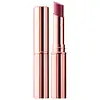What's inside
What's inside
 Key Ingredients
Key Ingredients

 Benefits
Benefits

 Concerns
Concerns

 Ingredients Side-by-side
Ingredients Side-by-side

Glycerin
HumectantWater
Skin ConditioningRicinus Communis Seed Oil
MaskingCaprylic/Capric Triglyceride
MaskingSucrose Stearate
EmollientEthylhexyl Stearate
EmollientOlus Oil
EmollientDipentaerythrityl Hexacaprylate/Hexacaprate
EmulsifyingHydroxystearic/Linolenic/Oleic Polyglycerides
EmollientC20-40 Alcohols
EmulsifyingIsodecyl Neopentanoate
EmollientButylene Glycol
HumectantPhenoxyethanol
PreservativeMicrocrystalline Cellulose
AbsorbentCera Alba
EmollientPolysorbate 20
EmulsifyingEthylhexylglycerin
Skin ConditioningChlorphenesin
AntimicrobialCellulose Gum
Emulsion StabilisingParfum
MaskingCI 77891
Cosmetic ColorantXanthan Gum
EmulsifyingHydroxypropyl Cyclodextrin
MaskingChondrus Crispus Extract
Skin ConditioningSqualane
EmollientHelianthus Annuus Seed Oil
EmollientPEG-8
HumectantCaramel
Cosmetic ColorantTocopherol
AntioxidantRetinol
Skin ConditioningDaphne Odora Callus Extract
Skin ProtectingAscorbyl Palmitate
AntioxidantNicotiana Sylvestris Leaf Cell Culture
Skin ConditioningPlumeria Rubra Flower Extract
Skin ConditioningCI 15985
Cosmetic ColorantUbiquinone
AntioxidantLecithin
EmollientCI 19140
Cosmetic ColorantAscorbic Acid
AntioxidantCitric Acid
BufferingCI 17200
Cosmetic ColorantAscorbyl Tetraisopalmitate
AntioxidantBenzoic Acid
MaskingHexyl Cinnamal
PerfumingBenzyl Benzoate
AntimicrobialLinalool
PerfumingHydroxycitronellal
PerfumingCinnamyl Alcohol
PerfumingEugenol
PerfumingGlycerin, Water, Ricinus Communis Seed Oil, Caprylic/Capric Triglyceride, Sucrose Stearate, Ethylhexyl Stearate, Olus Oil, Dipentaerythrityl Hexacaprylate/Hexacaprate, Hydroxystearic/Linolenic/Oleic Polyglycerides, C20-40 Alcohols, Isodecyl Neopentanoate, Butylene Glycol, Phenoxyethanol, Microcrystalline Cellulose, Cera Alba, Polysorbate 20, Ethylhexylglycerin, Chlorphenesin, Cellulose Gum, Parfum, CI 77891, Xanthan Gum, Hydroxypropyl Cyclodextrin, Chondrus Crispus Extract, Squalane, Helianthus Annuus Seed Oil, PEG-8, Caramel, Tocopherol, Retinol, Daphne Odora Callus Extract, Ascorbyl Palmitate, Nicotiana Sylvestris Leaf Cell Culture, Plumeria Rubra Flower Extract, CI 15985, Ubiquinone, Lecithin, CI 19140, Ascorbic Acid, Citric Acid, CI 17200, Ascorbyl Tetraisopalmitate, Benzoic Acid, Hexyl Cinnamal, Benzyl Benzoate, Linalool, Hydroxycitronellal, Cinnamyl Alcohol, Eugenol
Polybutene
Diisostearyl Malate
EmollientHydrogenated Polyisobutene
EmollientPolyethylene
AbrasiveVp/Hexadecene Copolymer
Microcrystalline Wax
Emulsion StabilisingMica
Cosmetic ColorantEthyl Vanillin
MaskingPentaerythrityl Tetra-Di-T-Butyl Hydroxyhydrocinnamate
AntioxidantPhospholipids
Skin ConditioningLimonene
PerfumingAroma
Hyaluronic Acid
HumectantSaccharomyces Cerevisiae Extract
Skin ConditioningSodium Chondroitin Sulfate
Skin ConditioningTocopherol
AntioxidantCitral
PerfumingDiamond Powder
AbrasiveDicalcium Phosphate
AbrasiveTripeptide-29
Skin ConditioningTin Oxide
AbrasiveCI 77891
Cosmetic ColorantIron Oxides
CI 15850
Cosmetic ColorantCI 19140
Cosmetic ColorantCI 15985
Cosmetic ColorantCI 42090
Cosmetic ColorantPolybutene, Diisostearyl Malate, Hydrogenated Polyisobutene, Polyethylene, Vp/Hexadecene Copolymer, Microcrystalline Wax, Mica, Ethyl Vanillin, Pentaerythrityl Tetra-Di-T-Butyl Hydroxyhydrocinnamate, Phospholipids, Limonene, Aroma, Hyaluronic Acid, Saccharomyces Cerevisiae Extract, Sodium Chondroitin Sulfate, Tocopherol, Citral, Diamond Powder, Dicalcium Phosphate, Tripeptide-29, Tin Oxide, CI 77891, Iron Oxides, CI 15850, CI 19140, CI 15985, CI 42090
Ingredients Explained
These ingredients are found in both products.
Ingredients higher up in an ingredient list are typically present in a larger amount.
Ci 15985 is a dye made from petroleum. It is synthetically created and approved by the FDA for use in foods and cosmetics.
The color of this dye is orange/yellow.
This ingredient can be found in makeup, sun care, and skincare.
Learn more about CI 15985CI 19140 is also known as Tartrazine. Tartrazine is a synthetic dye used in cosmetics, foods, and medicine to add a yellow color.
Tartrazine is created from petroleum and is water-soluble.
Some people may experience allergies from this dye, especially asthmatics and those with an aspirin intolerance.
Learn more about CI 19140Ci 77891 is a white pigment from Titanium dioxide. It is naturally found in minerals such as rutile and ilmenite.
It's main function is to add a white color to cosmetics. It can also be mixed with other colors to create different shades.
Ci 77891 is commonly found in sunscreens due to its ability to block UV rays.
Learn more about CI 77891Tocopherol (also known as Vitamin E) is a common antioxidant used to help protect the skin from free-radicals and strengthen the skin barrier. It's also fat soluble - this means our skin is great at absorbing it.
Vitamin E also helps keep your natural skin lipids healthy. Your lipid skin barrier naturally consists of lipids, ceramides, and fatty acids. Vitamin E offers extra protection for your skin’s lipid barrier, keeping your skin healthy and nourished.
Another benefit is a bit of UV protection. Vitamin E helps reduce the damage caused by UVB rays. (It should not replace your sunscreen). Combining it with Vitamin C can decrease sunburned cells and hyperpigmentation after UV exposure.
You might have noticed Vitamin E + C often paired together. This is because it is great at stabilizing Vitamin C. Using the two together helps increase the effectiveness of both ingredients.
There are often claims that Vitamin E can reduce/prevent scarring, but these claims haven't been confirmed by scientific research.
Learn more about Tocopherol